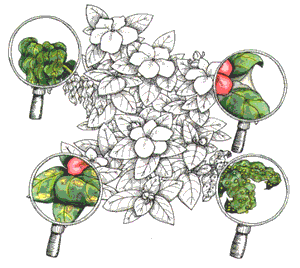 |
| Solving Impatiens Problems | |
|---|---|
| Symptom | Probable Cause |
| No Blossoms; Plant Wilts | Too Much Sun; Heat; Soil Dry |
| Excessive Foliage; Few Flowers | Too Much Fertilizer |
| Leaves Curled; Distorted | Aphids |
| Leaves Discolored; Deformed | Mites |
| Stunted Plants; Yellow Leaves; Root Lesions | Nematodes |
| Sudden Wilting; Stems Rot At Soil Line | Bacterial Wilt |
| Plants Stunted; Yellowed or Brown Spots on Leaves | Fungal Disease |
| Yellowed Foliage | Stem Rot |
No Blossoms; Plant Wilts in Summer Means Excessive Heat or Dryness
Impatiens will often wilt and stop blooming in the heat of the summer, especially if they are in too much sun. Keep watering and they will begin to bloom again when the weather cools. This is another good reason to use organic mulch since it cools the soil and keeps the blooms coming longer. Wilting may also indicate that the plants are struggling in too much sun for too long each day. Water well and, if it is early in the season, transplant young plants to a shadier site.
Excessive Foliage, Few Flowers Means Overfeeding
Impatiens rarely need much fertilizer. An overdose of liquid fertilizer which is quick-acting, will give them too much nitrogen all at once. They are stimulated to produce abundant foliage, so they have little energy left to produce flowers. This tender foliage also attracts aphids and other insects. Use a slow-acting, granular product sparingly, in the spring.
Plant Stunted, Leaves Yellowed or Lesions on Roots Means Nematodes
Root knot nematodes and lesion nematodes sometimes attack impatiens, especially in the South. Nematodes are not insects, but slender, unsegmented roundworms. Most are soil-dwellers, less than 1/20 inch long, invisible to the unaided eye. They have piercing-sucking mouthparts. Impatiens infested with nematodes look sickly, wilted, and stunted. They develop yellowed or bronzed foliage. Often they decline slowly and die. Their root systems are poorly developed, even partially decayed.
The effects of nematode activity are most apparent in hot weather when plants recover poorly from mid-day heat, staying wilted into the evening. Dig up and trash severely infested plants, making sure to also remove the soil around the roots. As a preventative, fertilize impatiens with fish emulsion diluted in water and poured on the soil as a drench. It repels nematodes.
Deformed or Dwarfed Flowers Means Tarnished Plant Bug
The tarnished plant bug is an active, green or brown insect. It sucks the life from young impatiens shoots and buds, causing deformed or dwarfed flowers. The 1/4 inch bug is mottled with markings of yellow, brown, and black. Look for a black tipped yellow triangle on each of his sides.
Tarnished plant bugs appear in early spring, becoming more numerous toward the end of summer. The simplest treatment is to hand pick early arrivals and drop them into a jar of soapy water. Use insecticide for major infestations. Use sprays early in the morning when bugs are least active. Spray visible bugs with a pyrethrin/pyrethrum insecticide according to the instructions on its label. The best way to control this pest is with thorough fall and spring cleanup. This will prevent it from overwintering.
For more information see the file Controlling Plant Bugs
Plants Wilting Suddenly, Stems Rotting at the Soil Line Signals Bacterial Wilt
A disease caused by a bacteria causes sudden wilting and collapse of impatiens plants. Yellowish masses of bacteria ooze out when the stems are cut. Stems are often rotted at ground level. Remove and discard in the trash severely infected plants and garden debris. Disinfect any tools by dipping them in a solution of hot water and household bleach or spritz them with household disinfectant spray. Avoid planting potatoes, tomatoes or eggplants nearby which are vulnerable to this same disease.
Plants Stunted, Yellowed or Brown Spots on Leaves Means Fungal Disease
Fungal diseases sometimes attack impatiens. A wilt disease works its way up from the base of the plant, causing leaves and branches to wilt and die. A leaf spot disease causes circular brown spots on the leaves. Stem rots attack impatiens stems at or near the soil level. Foliage turns yellow, wilts, and dies.
There is no practical treatment for these problems in inexpensive annual plants which die at the end of the season anyway. The best strategy is to promptly remove and discard badly infected plants with their soil in the trash to prevent the spread of the fungus to other plants. Do not grow impatiens continuously in the same location every year. Control weeds in and around the yard. Sterilize tools after use on infected plants with a spritz of household disinfectant spray or dip them in a solution of hot water and household bleach. Mulching helps prevent splash-borne infection in outdoor plantings. For long term prevention, lighten heavy soil with a mixture of perlite, vermiculite or peat moss and provide good drainage. Avoid overwatering. Space plants further apart to prevent crowding.
Click here for more information on Dealing with Fungal Disease

